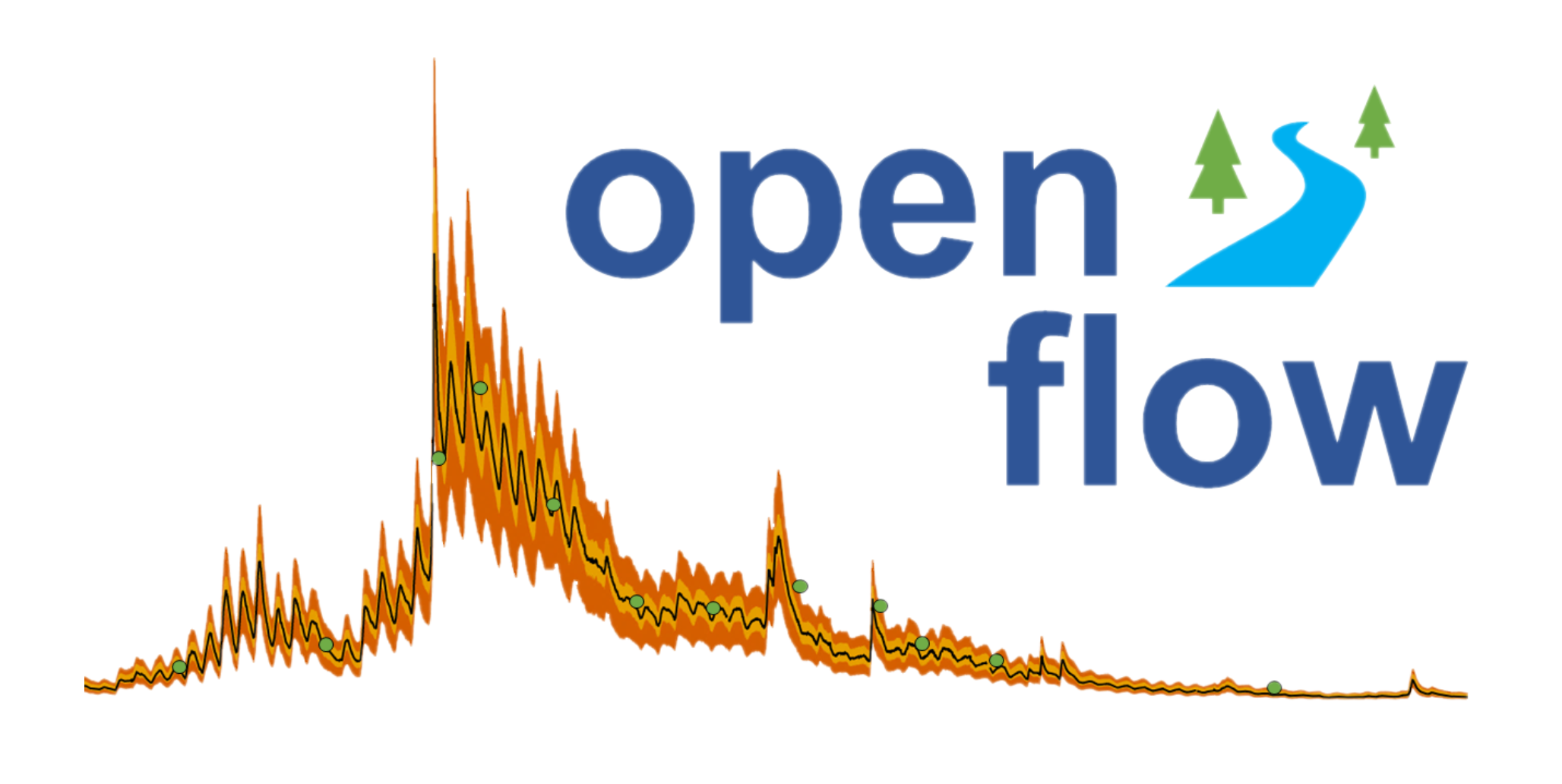

Welcome to openFlow!
Overview
This application allows you view and interact with select hydrologic data collected at 29 stream, river, and lake inflow/outflow sites across the National Ecological Observatory Network (NEON). NEON spans the continential United States and includes monitoring sites in Alaska and Puerto Rico. In this app you can visually explore data from the following NEON Data Products:
- Stage-discharge rating curves (DP4.00133.001)
- Continuous discharge (DP4.00130.001)
- Precipitation (DP1.00006.001)
- Land-water interface images (DP1.20002.001)
To learn more about each data product, follow the links above to data product landing pages and navigate to the ‘Documents’ section to find either Data Product User Guides (DPUG) or Algorithm Theoretical Basis Documents (ATBD) for each data product.
Using the App
Inputs
Before ‘Submit’
To run the app, users must select a NEON Domain ID and Site ID from dropdown menus and specify a Date Range to download and plot data. Visit the NEON website to learn more About Field Sites and Domains and Explore Field Sites.
Note: The openFlow app uses the neonUtilities R package to download data from the NEON API. Users that select larger date ranges (> 6 months) will experience longer wait times.
Users also have the option to enter their NEON API Token before running the app to link their app activity to their user account and enable faster download speeds. Learn more about the benefits of using an API token here.
Independent of ‘Submit’
The following checkbox inputs can be toggled either before or after a user selects ‘Submit’.
Include Discharge Science Review Quality Flags - If selected, shaded areas (grey) will plot in the background of the plotting field for time ranges when DP4.00130.001:csd_continuousDischarge:dischargeFinalQFSciRvw = 1.
Convert to Imperial Units - If selected, data in the ‘Continuous Discharge’ and ‘Rating Curve(s)’ tabs will be converted to imperial units. Units (Metric, Imperial) for the main groups of variables are:
- Discharge (liters per second, cubic feet per second)
- Stage (meters, feet)
- Precipitation (millimeters, inches)
Show in Dark Mode - If selected, the app will have a global dark theme.
Outputs
Metadata Table
The metadata table contains the following reach-scale variables that characterize the site that was selected:
Upstream watershed area (km2) - The area of land that drains water into the aquatic site.
Reach slope (%) - The gradient of the streambed from the upstream to downstream reach boundary of the aquatic site. Slope is measured using a total station during topographic site surveys.
Mean bankfull width (m) - The mean bankfull width of the channel measured at transects throughout the monitoring reach. At bankfull stage water is just beginning to spill out of the channel and into the floodplain. Bankfull flows typically occur at 1.5-year recurrence intervals.
D50 particle size (mm) - The diameter of bed substrate corresponding to 50% finer in the particle-size distribution. Substrate is measured at transects throughout the monitoring reach using 200-point pebble count methods.
Note: At NEON river sites (BLWA, FLNT, TOMB), reach slope, mean bankfull width, and D50 particle size are not measured. Also, at the Toolik Lake (TOOK) inflow and outflow locations, D50 particle size is not measured.
The ‘Continuous Discharge’ Tab
In the ‘Continuous Discharge’ tab, a timeseries plot is generated that plots three groups of data:
Discharge
- Continuous discharge (black line) - derived from DP4.00130.001:csd_continuousDischarge:maxpostDischarge
- Discharge Parametric Uncertainty (orange ribbon) - derived from DP4.00130.001:csd_continuousDischarge:withParaUncQLower2Std and DP4.00130.001:csd_continuousDischarge:withParaUncQUpper2Std
- Discharge Remnant Uncertainy (dark orange ribbon) - derived from DP4.00130.001:csd_continuousDischarge:withRemnUncQLower2Std and DP4.00130.001:csd_continuousDischarge:withRemnUncQUpper2Std
- Measured Discharge (green point) - derived from DP4.00133.001:sdrc_gaugeDischargeMeas:streamDischarge
- Historic Median Discharge* (grey line) - DP4.00130.001:csd_continuousDischarge:maxpostDischarge
Stage
- Continuous Stage (pink line) - derived from DP4.00130.001:csd_continuousDischarge:equivalentStage
- Stage Uncertainty (blue ribbon) - derived from DP4.00130.001:csd_continuousDischarge:stageUnc
- Measured Gauge Height (yellow point) - DP4.00133.001:sdrc_gaugeDischargeMeas:gaugeHeight and DP4.00130.001:sdrc_gaugePressureRelationship:gaugeHeight
Precipitation**
- Continuous Precipitation (blue line) - DP1.00006.001:PRIPRE_5min:priPrecipBulk or DP1.00006.001:SECPRE_1min:secPrecipBulk
- Precipitation Uncertainty (purple ribbon) - DP1.00006.001:PRIPRE_5min:priPrecipExpUncert or DP1.00006.001:SECPRE_1min:secPrecipExpUncert
* - Historic Median Discharge is calculated from all RELEASED data at a given site. Click here to learn more about NEON data releases.
** - The app defaults to primary prcipitation (DP1.00006.001:PRIPRE_5min) when plotting data from the Precipitation data product. If no primary precipitation data is available for a site, the app will plot secondary precipitation (DP1.00006.001:SECPRE_1min).
Table: The Preciptiation data product is not published for all NEON aquatic sites. If precipitation data is not published for a NEON aquatic site, the neonUtilities R package will pull data from the nearest co-located NEON terrestrial site. The site ID from which the precipitation data is pulled is included in the legend. Click here to learn more about co-located NEON sites.
| NEON Domain ID | NEON Aquatics Site ID | Precipitation Data Source Site ID |
|---|---|---|
| D01 | HOPB | HARV |
| D02 | LEWI | BLAN |
| D02 | POSE | SCBI |
| D03 | FLNT | JERC |
| D04 | CUPE | CUPE |
| D04 | GUIL | GUIL |
| D06 | KING | KONZ |
| D06 | MCDI | MCDI |
| D07 | LECO | GRSM |
| D07 | WALK | ORNL |
| D08 | BLWA | DELA |
| D08 | MAYF | TALL |
| D08 | TOMB | LENO |
| D10 | ARIK | ARIK |
| D11 | BLUE | BLUE |
| D11 | PRIN | PRIN |
| D12 | BLDE | YELL |
| D13 | COMO | NIWO |
| D13 | WLOU | WLOU |
| D14 | SYCA | SYCA |
| D15 | REDB | REDB |
| D16 | MART | WREF |
| D16 | MCRA | ABBY |
| D17 | BIGC | BIGC |
| D17 | TECR | TEAK |
| D18 | OKSR | TOOL |
| D18 | TOOK_inflow | TOOK |
| D18 | TOOK_outflow | TOOK |
| D19 | CARI | BONA |
All continuous data and uncertainties are averaged and plotted at a 20 minute temporal resolution regardless of the temporal resolution at which an attribute is published.
If there are no data published for an attribute in a given time range, the attribute will not be visible in the legend.
The ‘Rating Curve(s)’ Tab
In the ‘Rating Curve(s)’ tab, a plot is generated that shows all stage-discharge rating curves used to model continuous discharge for the time range specified by the user. Continuous discharge and stage-discharge rating curve data are linked by the curveID field. The app will identify all unique curveID values within the range of continuous discharge data and plot the stage-discharge relationship (black points), rating curve (black line), and uncertainties (parametric uncertainty = orange ribbon, remnant uncertainty = dark orange ribbon) for each rating curve.
Features
Plotly Features
Plotting in the openFlow app is done using the plotly R package. Plots created in plotly contain built-in functionality that allow users to better interact and interpret data. The plots in the openFlow app contain the following useful functionality built into the plots:
- Click and drag on the plot to zoom in and double click to autoscale both axes.
- Toggle visibility of attributes by clicking on them in the legend (double click on a legend attribute to view only this attribute in the plot.
- In the ‘Continuous Discharge’ tab, Continuous Discharge, Continuous Stage, Measured Discharge, and Measured Gauge Height attributes default to on while all other attributes default to off.
- In the ‘Rating Curve(s)’ tab, Rating Curve w/ Gaugings attribute defaults to on and Uncertainty defaults to off.
- Change discharge scales between linear and log using the buttons above the legend.
- Hover over attributes on the plotting field to see values at specific timestamps.
Render PhenoCam Image
- In the ‘Continuous Discharge’ tab, users can hover over any plot attribute and click to render an image of the site published in the PhenoCam Gallery. Images are queried from the PhenoCam API for the timestamp closest to the timestamp clicked by the user.
Download Handler
-
In the ‘Continuous Discharge’ and ‘Rating Curve(s)’ tabs, users can download the plots as HTML files. When the plots are rendered in the app, a ‘Download Graph’ button will appear in the lefthand panel of the app above the Metadata Table. If downloaded, the HTML file will retain all the interactive functionality built into plotly. Note: Users that download data for larger date ranges (> 6 months) will experience longer wait times.
-
Users can also download PhenoCam images. When PhenoCam images render in a new window, users can click the ‘Download Phenocam Image’ button to save the image as a PNG file.
Change Log
2024-03-04: Updated multiple data sources through NEON data release RELEASE-2024
2022-08-09: Remove package dependencies ‘stageQCurve’ and ‘measurements’
2022-07-25: Major updates include plotting NEON precipitation data, rendering NEON PhenoCam images via a click event, download buttons for plots and images, aesthetic updates to color paletes, axes, and app themes, and an ‘About the App’ tab.
2022-02-04: Updates for app to work with TOMB data
2021-09-16: Updates for app to work with TOOK data
2021-08-05: Original creation
Additional Information
Contact Us
Questions or Comments About the App?
NEON is always looking to improve the user experience! If you have any comments, questions, or general feedback about the app, please follow the link below to contact the app developer and enter ‘Zach Nickerson’ in the Direct to Staff Member field.
Find a Bug?
Is the app not working as expected? Do you have an enhancement request for the app? Please submit a Github issue here.
Credits & Acknowledgements
Authors:
James Ross - email: ross.james94@gmail.com
Divine Aseaku - email: divineaseaku@gmail.com
Zachary L. Nickerson - email: nickerson@battelleecology.org
The National Ecological Observatory Network is a project solely funded by the National Science Foundation and managed under cooperative agreement by Battelle. Any opinions, findings, and conclusions or recommendations expressed in this material are those of the author(s) and do not necessarily reflect the views of the National Science Foundation.
License
GNU AFFERO GENERAL PUBLIC LICENSE Version 3, 19 November 2007
Disclaimer
Information and documents contained within this package are available as-is. Codes or documents, or their use, may not be supported or maintained under any program or service and may not be compatible with data currently available from the NEON Data Portal.
Last Updated: 2022-07-26